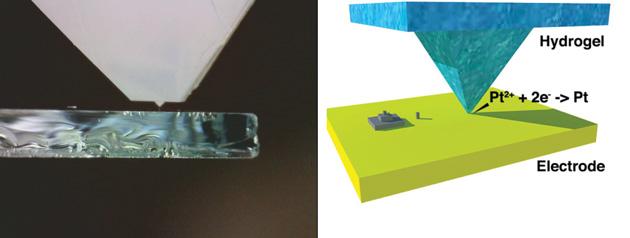Results 1 to 7 of 7
-
12-05-2014, 02:02 PM #1
Researchers Develop Nanoscale 3D Printing Pen
A team of scientists from South Korea, led by Seongpil Hwang, have developed a new 3D printing device that works on the nanoscale. Tested using platinum deposited onto a gold electrode, the 3D printing pen utilizes a hydrogel pyramid at the tip to interact with the ultrananoelectrode. The new pen can be a viable alternative to traditional glass nanopipettes, offering scientists a reliable and cost-effective new option. Check out more: http://3dprint.com/28979/nanoscale-3d-printing-pen/

-
12-05-2014, 02:30 PM #2Technician

- Join Date
- Oct 2014
- Posts
- 94
I'm more curious how they pulled off a nano-positioning system...
-
12-05-2014, 03:47 PM #3Engineer-in-Training

- Join Date
- Oct 2014
- Posts
- 314
I would think that would be the easy part. Positioning resolution is simply a function of the number of steps in your motor multiplied by the linear distance traveled per step. Decrease that linear distance through a series of gears and you get progressively finer motion.
For instance, a nema17 like we're all used to has 200 steps. Direct drive a lead screw with 10 threads per inch and you get 2000 steps per inch or .0005" resolution. Put a gear reduction between the stepper and screw with a ratio of say 10:1 (not unreasonable) and now you have 20000 steps per inch or .00005". 100:1 gives you .000005" and so on. Lash can be handled for each stage of gearing to keep precision up so your positioning is repeatable. And that doesn't take into account steppers with more steps than our 17's nor does it utilize microstepping.
-
12-09-2014, 07:35 AM #4Technician

- Join Date
- Oct 2014
- Posts
- 94
-
12-10-2014, 02:12 AM #5Student

- Join Date
- Dec 2014
- Location
- Sweden
- Posts
- 1
 PiezoMotors for ultra-high positioning precision
PiezoMotors for ultra-high positioning precision
You can easily achieve ultra-high positioning precision with e.g. PiezoMotors - http://www.piezomotor.com/technology/precision/
No gearboxes or screws would be required here...
-
12-10-2014, 07:49 AM #6Engineer-in-Training

- Join Date
- Oct 2014
- Posts
- 314
Covered that at least partially in my original post. Repeatable positioning is achieved through precision drivetrain design including compensation for, or elimination of, lash in the drive mechanism. That gets you close. To get the rest of the way you need a feedback loop. Something like an LVDT gets added to the system as a position reference so you're not relying entirely on counting the steps of the drive motor. Same basic idea as the closed loop fueling in a modern car. You have a preset fuel value (or step count for the printer) based on input variables like engine speed, air temp, etc. (steps per revolution, distance traveled per step). This is set in the programming as defaults. The system runs and checks the results by measuring unburnt hydrocarbons with an 02 sensor (or checks the position with an LVDT or similar). The actual results are compared to the expected results and offsets are automatically added in real time to adjust as needed.
Now I may be completely off on the LVDT thing but the basic idea of an input, output, measure, adjust loop is how extreme precision is done in any application.
-
12-10-2014, 08:47 AM #7Technician

- Join Date
- Oct 2014
- Posts
- 94
Use of an LVDT or a linear encoder would be revolutionary in the consumer 3D printer field and I haven't seen anyone do it on a large scale yet. For the "normal" consumer level, it would also allow for the elimination of stepper motors, which means no more annoying printer noise.
That being said, if I had to make a bet it would be RajPats use of piezo motors.






 Reply With Quote
Reply With Quote





Do bed magnets deteriorate.
04-29-2024, 01:35 AM in General 3D Printing Discussion